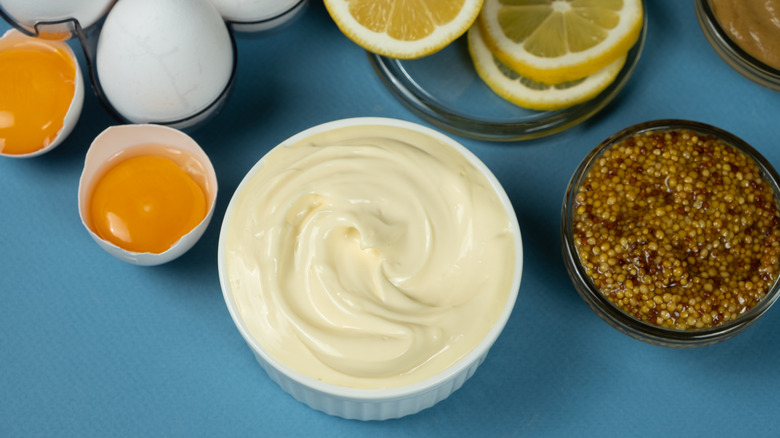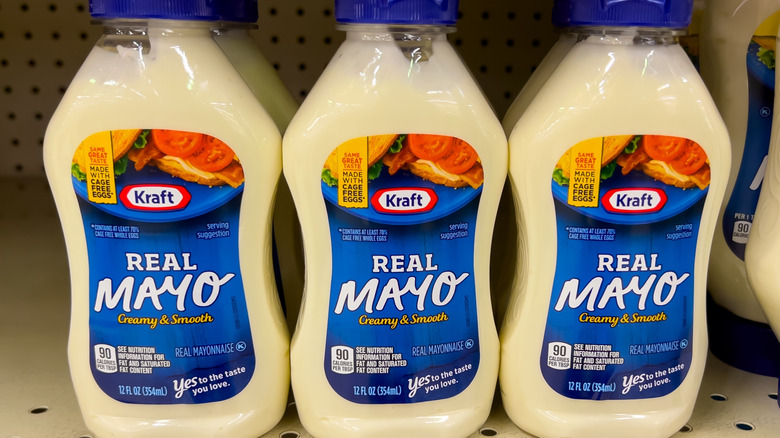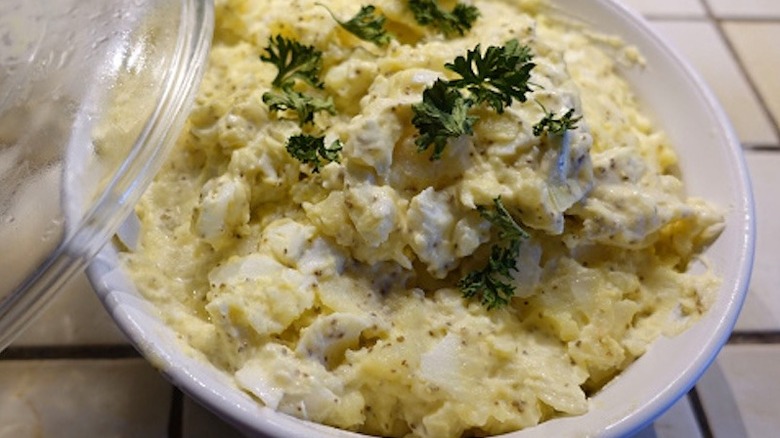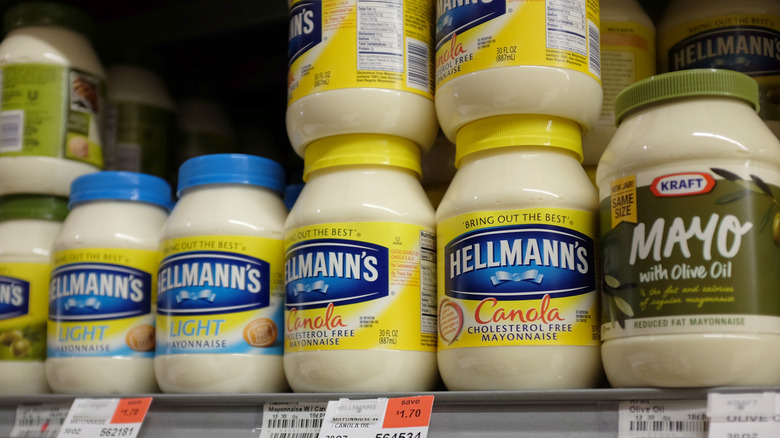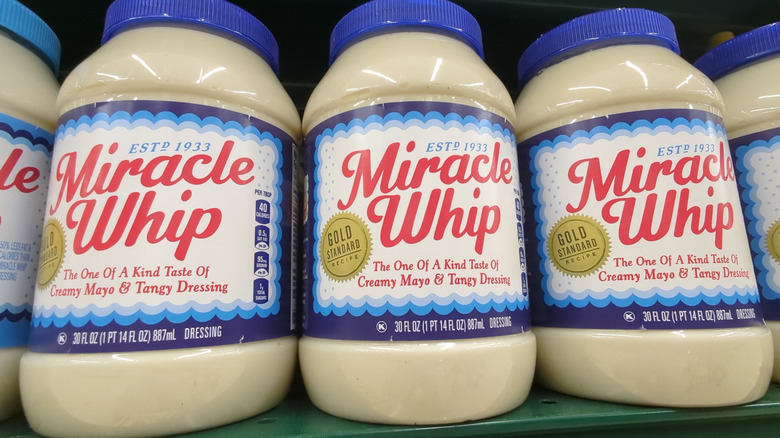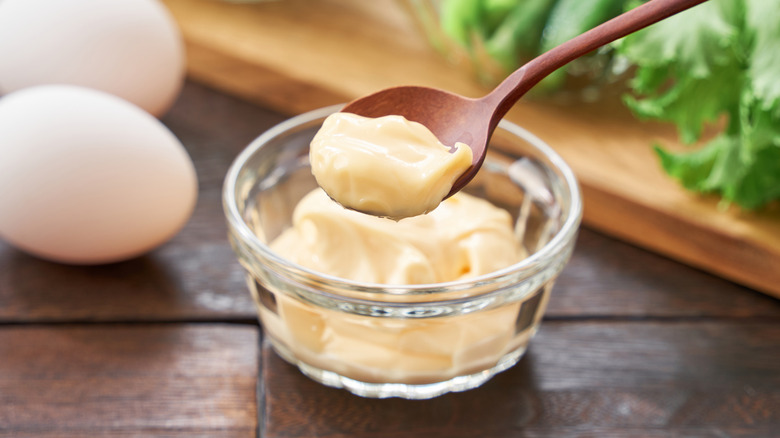Mayonnaise Myths You Should Stop Believing
It's probably not the first thing that comes to mind at the mention of staple food, cooking necessity, or even condiment. And yet mayonnaise is very important and versatile, an enduring and vital ingredient in so many world cuisines, but particularly in the patchwork of American food. Mayo can be used as a binder in casseroles, as an enveloping dressing for egg, chicken, and tuna salad, and it's most often employed to add moisture and flavor to many of the signature sandwiches of all 50 states and then some. Mayonnaise is even crucial for the best crab cakes. Whether it's homemade or purchased for relatively cheap at any and every supermarket in the country, mayonnaise is a part of life, for better or for worse.
It's such a mundane, everyday item, made from basic ingredients, and inherently simple — yet mayonnaise has historically inspired a great deal of revulsion, as well as appreciation and love. Moreover, feelings about mayonnaise, and a collective lack of understanding of it, has generated a lot of misinformation that lives in the ether. Let's look into the lore and mythology of mayonnaise — and point out how much of it is just plain not true.
Mayonnaise is a simple mixture
Perhaps armed with the vague sense that mayonnaise is something that can be easily prepared at home with just a few simple ingredients found in the pantry or fridge, or because it comes in the jar ready to go without any extra steps necessary, there persists the notion that mayonnaise is a blend of ingredients. It's so closely associated with other frequently used condiments and spreads, after all, which are just a sum of their parts — like ketchup, barbecue sauce, or mustard, which are fairly simple preparations of a few ingredients all jumbled up together.
For while mayonnaise may technically be a mixture by the most general definition of the word, technically speaking, mayonnaise is the result of a chemical and scientific process called an emulsion. That identifies the substance that comes from an almost miraculous and counterintuitive method. Without an emulsifying agent, the main ingredients in mayonnaise wouldn't physically be capable of blending or combining. Mayonnaise is essentially just vegetable oil and eggs. The yolk of the latter contains a naturally occurring material called lecithin. That emulsifying agent unites and breaks down the oil and eggs on a molecular level, allowing all of the ingredients to meld together and stay that way.
Mayonnaise is a dairy product
It's totally understandable why people might think that mayonnaise is a dairy product. It's often used in addition to or in lieu of things like sour cream, cream-based soups, or plain yogurt in vintage casseroles and contemporary dishes, as it adds a similarly smooth, velvety texture and thickening effect. It also bears a distinctively white color. But unlike other creamy condiments like crème fraîche or cream cheese, mayonnaise isn't a substance that comes from milk. Almost all mayo is completely dairy free, in fact. Mayonnaise gets its uniquely tangy taste and thick texture from eggs reacting with oil and an acid. The lecithin present in egg yolk is an emulsifier, forcing the oil to bind with water and providing a creamy sensibility.
If one is lactose intolerant and avoids mayonnaise out of fear of the physical effects, eat it without worry. That also means it's safe for vegetarians, but not for vegans — eggs aren't meat, but they certainly come from an animal. However, vegan-friendly mayonnaises can be found in supermarkets or made at home, utilizing a plant-based source like soy or peas.
Mayonnaise must be refrigerated
With commercially canned and jarred foods widely available for decades, proper storage of such foods is embedded knowledge at this point. When one buys an unrefrigerated product from the supermarket, it can stay in the pantry or on a shelf as long as it's not opened. Once the seal is literally broken and air is introduced, one best tightly close the lid or wrap it up in some other way and place it all in the refrigerator. If you don't, the food will turn bad very quickly and bring food poisoning symptoms to whomever dares eat it. This process is conducted every time a new jar of mayonnaise is opened: The lid goes back on, and it stays in the fridge, where it will remain fresh and safe for months.
While mayo is one of the most feared sources of food-based illness, and it's treated with care, it's actually not necessary to store mayonnaise — in its original container with nothing else added to it — in a refrigerator. Corporate mayo is produced with acids like lemon juice and/or vinegar. Those act as natural preservatives, which help mayonnaise keep its integrity even at room temperature. Be warned, however: Shelf mayo doesn't last as long as chilled mayo does.
Mayonnaise-based salads are bound to make you ill
The one thing seemingly everybody knows about mayonnaise is also mostly incorrect. As far as many people are concerned, mayonnaise turns almost instantly dangerous or deadly when it's taken outside. Used as the sauce or dressing for chicken salad or potato salad at a picnic, potluck, or party, mayonnaise, as common knowledge holds, instantly and rapidly rots as it warms up under the sun, inviting in all kinds of food-borne illness and the gastrointestinal havoc to come.
That's not entirely true, or at least it's not true as much as it once might have been. Mayonnaise, when used in a dish, is perishable chiefly because it's made with eggs. The U.S. Department of Agriculture gives mayo-laden salads a safety period of roughly two hours maximum, and that's at room temperature and without any chilling or refrigeration happening. Modern store-bought mayo, unlike the homemade stuff of the past, is also treated with preservatives, which help it last and stay safe for longer. The acid in the lemon juice used in mayo also helps preserve foods slightly. Moreover, any deterioration isn't necessarily the mayo's fault. Meat and veggies change the acidity level of the dish, allowing bacteria to thrive.
All mayonnaise is the same
When one goes to the average grocery store to pick out a jar or squeeze bottle full of mayonnaise, they're presented with a daunting array to choose from. All those transparent containers full of fluffy white emulsions of oil and eggs all certainly look the same, and whether you buy Duke's, Hellman's, Best Foods, or a more obscure brand or private label mayonnaise, you might not taste much of a difference when it's slathered on some bread as part of a sandwich. Hellman's and Best Foods, for example, are the exact same mayonnaise — the name on the label depends on where in the U.S. the jar was purchased.
While one can still try and rank store-bought mayonnaise brands from worst to best, move out geographically a bit and mayonnaise does start to change. There are significant differences between American-made mayo and Japanese mayo, for example. The leading brand of that style is Kewpie, and it doesn't look nor taste like its Western counterparts because it's made with a different set of instructions. Kewpie and other Japanese mayos have a slightly yellow appearance, along with a texture that's stronger and even creamier. That's all because Japanese mayo uses just the yolk from the eggs, while American mayo utilizes the yolk and the white. And while Western mayo manufacturers add a tang with the addition of distilled vinegar, in Japan, companies use rice vinegar or apple cider vinegar, imparting a sweetness into the mayo.
People who don't like mayonnaise are just picky eaters
Mayonnaise is an odd food in that it's just as easy to love as it is to hate, and no matter which side you align with, you can kind of see the other side's point. On one hand, it's what makes sandwiches creamy and luxurious; on the other, it's a savory gloop that doesn't resemble the eggs and oil from which it originated. Perhaps it's just best not to think too much about mayonnaise when eating it, so as to prevent a feeling of getting grossed out, which is a common reaction to mayonnaise.
But those among us who hate mayonnaise aren't just being contrarian, immature, or picky: There's a deep-seated biological imperative at play. Paul Rozin, a University of Pennsylvania psychology professor specializing in the motives behind disgust, said in an interview with Bustle that the sense that some foods are repulsive and should be avoided is the body's evolved defense to prevent the eating of rotten or germ-laden food. So many natural foods that decay turn slimy, so it makes a lot of sense why some people loathe the very slimy mayonnaise. Several studies have shown that relative sliminess is one the major triggers for aversions to specific foods.
Miracle Whip is just sweetened mayonnaise
Mayonnaise has its passionate fans and avid haters, but that's a simple fight compared to what happens when an ostensibly similar but ultimately way different condiment enters the conversation. The old Miracle Whip vs. mayonnaise debate has raged for decades, pitting the centuries-old simplistic emulsion of eggs and oil against a marvel of modern food science. Kraft debuted Miracle Whip in 1933, offering it as a less expensive alternative to jarred mayonnaise during the difficult economic times of the Great Depression. It was named after an emulsifying machine built in-house by employee Charles Chapman, and the recipe was based on a then-popular concept called boiled dressing. Home cooks took eggs, vinegar, water, milk, spices, salt, and a considerable amount of sugar, reduced it, and then added a thickening starch of some kind. It replicated mayo without the use of expensive vegetable oil.
Today, the FDA makes Kraft label Miracle Whip as a salad dressing, because it lacks the oil necessary to call the substance mayonnaise. Because it lacks that key ingredient, Miracle Whip isn't mayonnaise — but it's definitely sweeter, owing to the sugar used (which isn't found in real mayo).
Aioli is merely fancy mayonnaise
It looks like mayonnaise, it tastes like mayonnaise, and it comes in a little metal ramekin at sit-down burger joints like a side of mayonnaise for dipping fries does. But aioli is not actually mayonnaise, or even a version of it gussied up with extra spices or top-shelf ingredients.
The two condiments are fundamentally different on a basic level. Aioli developed in the Provence region of France and Spain, and the main ingredient is crushed garlic, and a lot of it. After being broken down into a paste, the garlic gets a touch of salt, a bit of lemon juice, and a vegetable oil of some kind. The lemon juice emulsifies the oil into everything else and results in a creamy, gloopy mixture with the consistency of mayonnaise. But that's still an aioli. Mayonnaise, by definition, is made with eggs — whole ones. Aioli, if the recipe used even calls for eggs, only makes use of the yolks. One can try to simply transform mayo into aioli, or something akin to it, but they're really condiment cousins, not topping twins.
Mayonnaise is good for your hair
Made of mostly natural ingredients, one could be mistaken for think rich, white, and glossy mayonnaise is some kind of health and beauty product. To be sure, the internet is rife with instructions for mayonnaise hair masks. Such a do-it-yourself cosmetic kit is a tempting project because it can be done cheaply, and with ingredients one probably already has in the home, particularly mayonnaise. Those articles all promise the same things: that the addition to mayo to one's hair will undo the detrimental effects of dyes and heat treatments and restore strength and luster. Supposedly, it's all because of the eggs in mayo. Eggs are high in protein, and that macro is said to help hair follicles get hearty. And if the oil used in that mayo is olive or canola, those lend long-lasting moisture to the hair.
There isn't a lot of scientific backing or proof to any of the hair mask theories that float around online. Adding oil to dry hair will of course make it oilier, particularly curly or wavy locks, which tend to lack naturally occurring oils. Straight hair doesn't tend to need the addition of outside oils. As for building strength, it's mostly conjecture and hearsay. There isn't nearly enough protein in even a large portion of mayonnaise to do any hair any good.
Mayonnaise isn't very healthy
The proof for mayonnaise being an unhealthy food is right there in the numbers. Just one 15-gram serving, a tablespoon's worth, packs 90 calories and 10 grams of fat, of which 1 ½ grams is the heart-unfriendly saturated fat. This means that pretty much all of the calories in mayo come from fat, because there's next to no carbohydrates or protein in the stuff. This makes mayo look pretty bad from a health standpoint, particularly when it goes head-to-head with other common condiments, like the fat-free and barely caloric mustard and ketchup.
But mayonnaise isn't all bad news, or uniformly unhealthy. Because it can be made with a variety of oils, whichever one that's used imparts its healthy profile into the mayonnaise. Olive oil and avocado oil provide mayo with omega-3 fatty acids, which promote cardiovascular health. And all kinds of mayo are imbued with vital nutrients that the body needs, particularly Vitamin E and Vitamin K.
A French chef invented mayonnaise in the 1700s
Specifically when and where mayonnaise was created are details obscured by the passage of time. The most commonly cited origin story takes place in 1756. In the early days of the Seven Years' War, forces from France attacked Port Mahon, a Spanish stronghold on the Mediterranean island of Minorca. Under the direction of the Duke of Richelieu, the French secured Port Mahon, and the embedded chef wished to throw a celebratory feast. One particular dish he wished to make required the use of cream, and as he wasn't able to get any on a fairly remote island in the middle of war, he got an ingredient with the consistency he wanted by making an emulsion of oil and eggs. The chef called his creation mahonnaise, after Port Mahon.
That's the story that's perpetuated through the ages, but it's not necessarily true. It's probable or even likely that the chef essentially stole the idea from Salsa Mahonesa, or "sauce of Mahon." He claimed as his own a local preparation devised by Spanish residents. But this story may also be culinary lore, as mayonnaise wasn't broadly known in France for another 50 years. In the 19th century, influential French chef Antoine Careme used a sauce called magononnaise, which gets its name from manier, the French word for "to stir," and which accurately describes the mayo creation process. It could also be a derivative of moyeu, an old French word for egg yolk.
Hellman's came up with the idea of mayo as a cake ingredient
For those who retch at the mere mention of mayonnaise, the thought of using it in a chocolate cake is downright unconscionable. The technique has been adopted by countless home cooks and even professional pastry chefs. It all goes back to Hellman's and Best Foods, which published the recipe as a way to push sales and get people to expand their minds in terms of mayonnaise's uses. "Cakes and Cookies with Personality: Exciting New Recipes for Cakes, Cookies, and Frostings" was a pamphlet published by Best Foods in 1937, and it included a recipe for mayo cake.
Empire Mayonnaise distributed a similar recipe two years later, and Kraft soon followed suit with a Miracle Whip Cake idea. Such cakes with a surprising and bolstering ingredient were all the rage in the 1940s, and Hellman's still gets credit for starting the trend. But it didn't invent the cake in its corporate kitchen. It lifted the recipe from "Home Economics Department," a column by Martha Lee in the Oakland Tribune. In 1927, Lee offered up a recipe for chocolate cake made with dates, walnuts, nutmeg, and cinnamon, as well as a homemade mayonnaise of eggs and oil whisked together. And really, using mayo in a cake isn't all that weird — eggs and oil often go into cake, just separately.

